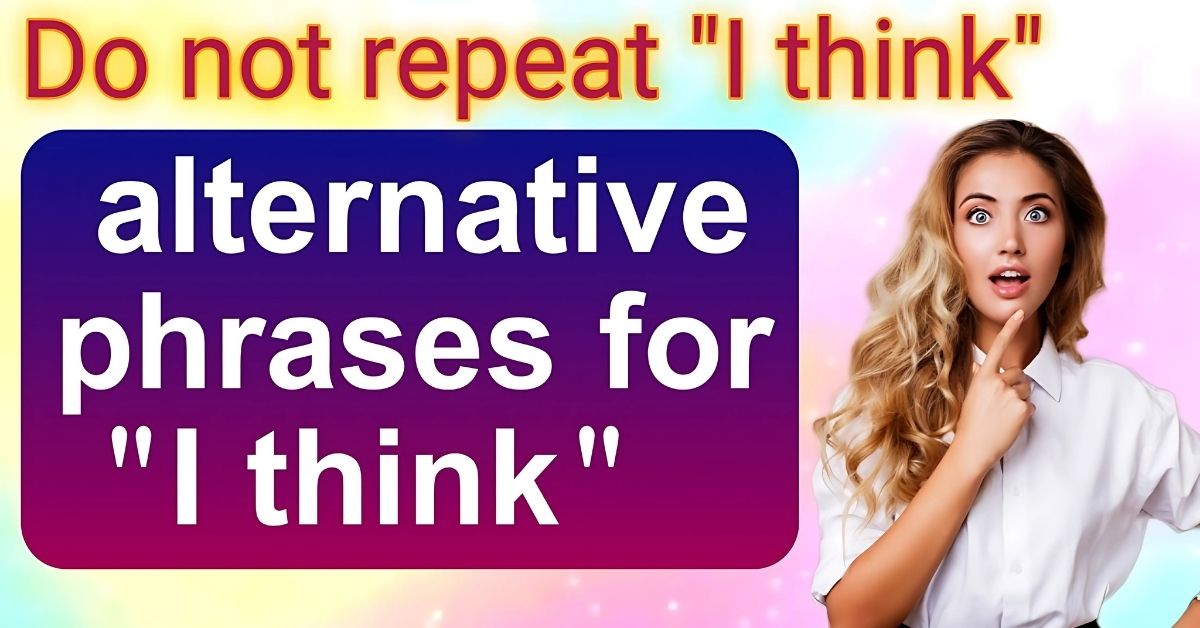If you keep using the same words in your essay, it can sound boring. That’s why knowing 20 Other Ways to Say “I Believe” in an Essay can make your writing stronger. This list gives you different phrases so your work feels fresh. It also helps you sound confident without repeating yourself.
When you use 20 Other Ways to Say “I Believe” in an Essay, you make your ideas stand out. These phrases fit formal and casual writing. They help you express your views in a clear way. Readers will notice the variety in your words. That makes your essay more engaging.
List of Other Ways to Say “I Believe” in an Essay
When writing essays, especially in academic or professional settings, it’s important to have a diverse vocabulary to share your personal stance. Using the same phrase repeatedly can limit the depth and style of your writing. A wide range of alternatives allows you to adjust the tone based on the subject matter, audience, or context. Below is a list of expressions that serve as excellent replacements for “I believe” in essays. Each option carries a slightly different tone, level of formality, and nuance, making them useful for a variety of writing situations. Learning how to use them correctly will help you maintain a smooth flow in your work and connect more effectively with the reader.
also reaide: other ways to say i love you so much
In My Opinion
The phrase “In my opinion” is one of the most common and widely accepted alternatives to “I believe.” It’s suitable for both formal and informal essays, allowing you to clearly present your viewpoint without sounding overly forceful. In academic writing, it works well when you want to share your stance while also leaving room for other interpretations. For example, in a persuasive essay, you might write, In my opinion, renewable energy policies will play a crucial role in reducing carbon emissions in the USA. This phrasing is direct and confident while still respectful of other perspectives.
When using this phrase, it’s best to follow it with evidence or reasoning. It shouldn’t be a standalone statement. Instead, let it serve as a bridge into your argument. This way, the reader can see that your opinion is backed by research or logical thinking, making your writing more persuasive and credible.
As I See It

The phrase “As I see it” adds a slightly more personal and conversational touch than “In my opinion.” It’s still appropriate for essays, especially those that mix factual analysis with personal interpretation. For instance, in a reflective essay on literature, you might write, As I see it, the author’s choice of symbolism highlights the deep cultural divide between the characters. This wording draws the reader into your perspective in a way that feels natural.
While this phrase is useful, it’s important to ensure your tone remains professional in formal essays. Pair it with well-structured analysis and credible sources so it doesn’t feel overly casual. Used well, it can make your writing engaging and relatable while still conveying authority.
From My Perspective
“From my perspective” works well when you want to frame your opinion as one viewpoint among many. It’s particularly effective in essays that compare different ideas or interpretations. For example, you might write, From my perspective, urban planning should prioritize green spaces as much as infrastructure development. This phrase emphasizes that you are contributing to a larger discussion without dismissing opposing viewpoints.
This approach can be powerful in academic debates, as it shows open-mindedness and awareness that other perspectives exist. It invites discussion rather than closing it, making it ideal for essays where collaboration or dialogue is encouraged.
In My View
The expression “In my view” is another formal yet personal way to introduce your opinion. It’s straightforward and professional, making it a good fit for argumentative or analytical essays. In academic writing, you could use it like this: In my view, early childhood education has the greatest long-term impact on a society’s economic growth. This keeps your tone confident while maintaining academic credibility.
By using this phrase strategically, you avoid sounding repetitive and show that you have a clear stance. It also helps guide the reader to your perspective while setting up your supporting evidence.
It Is My Conviction That
When you want to express a strong belief backed by evidence or moral reasoning, “It is my conviction that” is a powerful choice. This phrase conveys certainty and determination. For example, It is my conviction that access to clean drinking water is a basic human right. This shows that your belief is deeply held and based on principle.
Because it’s such a strong phrase, it’s best reserved for statements you can fully support with compelling arguments or data. In formal essays, it can be especially persuasive when used sparingly and strategically.
To My Understanding
“To my understanding” is particularly useful when you’re presenting your interpretation of facts or events. It suggests that your opinion is based on your current knowledge. For example, To my understanding, the policy changes were implemented to address economic inequality. This phrasing signals that you’re open to new information while still expressing your viewpoint.
It works well in essays that analyze data, policies, or literature, where multiple interpretations might exist. It can also help soften a statement, making it less confrontational in debates.
As Far As I’m Concerned

The phrase “As far as I’m concerned” adds a touch of personal emphasis to your writing. It’s often used to express a strong preference or stance. For example, As far as I’m concerned, transparency is the most important quality in government leadership. This shows conviction while still keeping the tone approachable.
In essays, it’s most effective in opinion-driven writing, though it can also appear in reflective pieces. Just be mindful to support your statement with reasoning or evidence to maintain credibility.
In My Estimation
“In my estimation” adds a measured and analytical tone to your opinion. It works well in evaluative essays where you’re weighing evidence before forming a conclusion. For example, In my estimation, the proposed plan will lead to long-term economic stability. This phrase signals that your belief comes from careful consideration.
It’s an excellent choice when you want to show that your view is informed and deliberate, rather than impulsive.
From My Standpoint
The phrase “From my standpoint” helps anchor your opinion in your personal position or role. It’s especially useful when your perspective is shaped by specific experiences or expertise. For example, From my standpoint as an educator, early intervention is critical for student success. This phrase adds credibility because it ties your belief to your background.
In formal essays, it can strengthen your argument by showing that your position is informed by direct involvement in the subject.
It Seems to Me That
When you want to introduce a softer, more tentative opinion, “It seems to me that” is a great choice. For example, It seems to me that remote work has improved overall productivity in many industries. This phrase allows room for other interpretations, making it useful in balanced discussions.
It’s ideal for situations where you don’t want to sound overly forceful or when you’re presenting an opinion that’s open to debate.
As I Understand It
“As I understand it” is a phrase that suggests your belief is based on the information you have. For instance, As I understand it, the new regulations aim to reduce environmental impact. It’s a polite and non-confrontational way to present your stance.
This phrase is especially useful in essays that analyze legislation, research findings, or complex topics where understanding can vary.
In My Judgment
“In my judgment” conveys authority and decision-making ability. It’s effective when you want to emphasize that your conclusion comes from careful thought. For example, In my judgment, investing in renewable energy is the most sustainable choice for the future.
This phrase can add weight to your arguments, making them sound reasoned and deliberate.
In My Experience
When your opinion is shaped by personal encounters or history, “In my experience” is an ideal choice. For example, In my experience, team collaboration leads to more innovative solutions. This phrase adds authenticity and relatability to your writing.
It’s especially effective in reflective essays or when you want to connect with the reader through shared experiences.
It’s My Belief That
“It’s my belief that” is a close variation of “I believe” but can sound smoother and more formal. For example, It’s my belief that access to quality healthcare should be universal. This phrasing can be a subtle way to avoid repetition while keeping your meaning clear.
It works well in persuasive essays where you want to maintain a steady, confident tone.
From My Vantage Point
The phrase “From my vantage point” adds imagery and suggests you have a unique position or insight. For example, From my vantage point, the market trends indicate a strong shift toward sustainable investments.
It’s a powerful phrase when you want to highlight the distinct angle from which you’re approaching a topic.
As I Perceive It
“As I perceive it” focuses on your personal interpretation. For example, As I perceive it, the novel reflects deep cultural conflicts beneath the surface narrative. It’s ideal for literary analysis or essays that explore abstract concepts.
This phrase emphasizes that your belief is shaped by how you interpret the facts or events.
In My Assessment
“In my assessment” conveys evaluation based on evidence or analysis. For example, In my assessment, the company’s strategy will strengthen its competitive position in the USA market.
It’s perfect for analytical essays or reports where you weigh data before forming a conclusion.
To My Way of Thinking
The phrase “To my way of thinking” is slightly informal but still works in essays when used carefully. For example, To my way of thinking, education reform should focus more on teacher training than curriculum changes.
It’s best for opinion-based essays where your personal reasoning is central to the discussion.
In My Mind
“In my mind” adds a personal and reflective tone to your belief. For example, In my mind, creativity is the most valuable skill for the future workforce.
It works well in essays that blend analysis with personal reflection, giving your argument a relatable touch.
As I Interpret It
“As I interpret it” highlights analysis and critical thinking. For example, As I interpret it, the policy changes aim to promote equity rather than uniformity. This phrase is especially useful in essays about literature, law, or history where interpretation is key.
It signals that your belief is the result of thoughtful analysis rather than assumption.
Pros and Cons of Diversifying Expression
Using a variety of phrases instead of “I believe” keeps your writing fresh and engaging. It shows your ability to adapt your tone and choose language that fits the context. On the positive side, this variety can make your essay more persuasive, demonstrate your vocabulary skills, and help maintain reader interest. On the downside, overusing alternatives can distract from your main argument, especially if they feel forced. The key is balance use different expressions naturally and in the right context. This way, you can communicate your beliefs clearly while keeping your essay polished and professional.
Conclusion
You must remember that repeating the same phrase can make an essay dull. That’s why 20 Other Ways to Say “I Believe” in an Essay is a must for good writing. You must use different words to keep the reader interested. This list is a must for anyone who wants clear and strong sentences.
You must try these 20 Other Ways to Say “I Believe” in an Essay in your school or work writing. They must help you sound smart and confident. You must pick the right phrase for each point. This must improve flow and keep your ideas fresh.

Grammerroot is your trusted source for mastering English grammar and language skills. From simple rules to advanced tips, we help learners build strong foundations through easy-to-understand content. Learn smart, learn right — only at Grammer Root.




